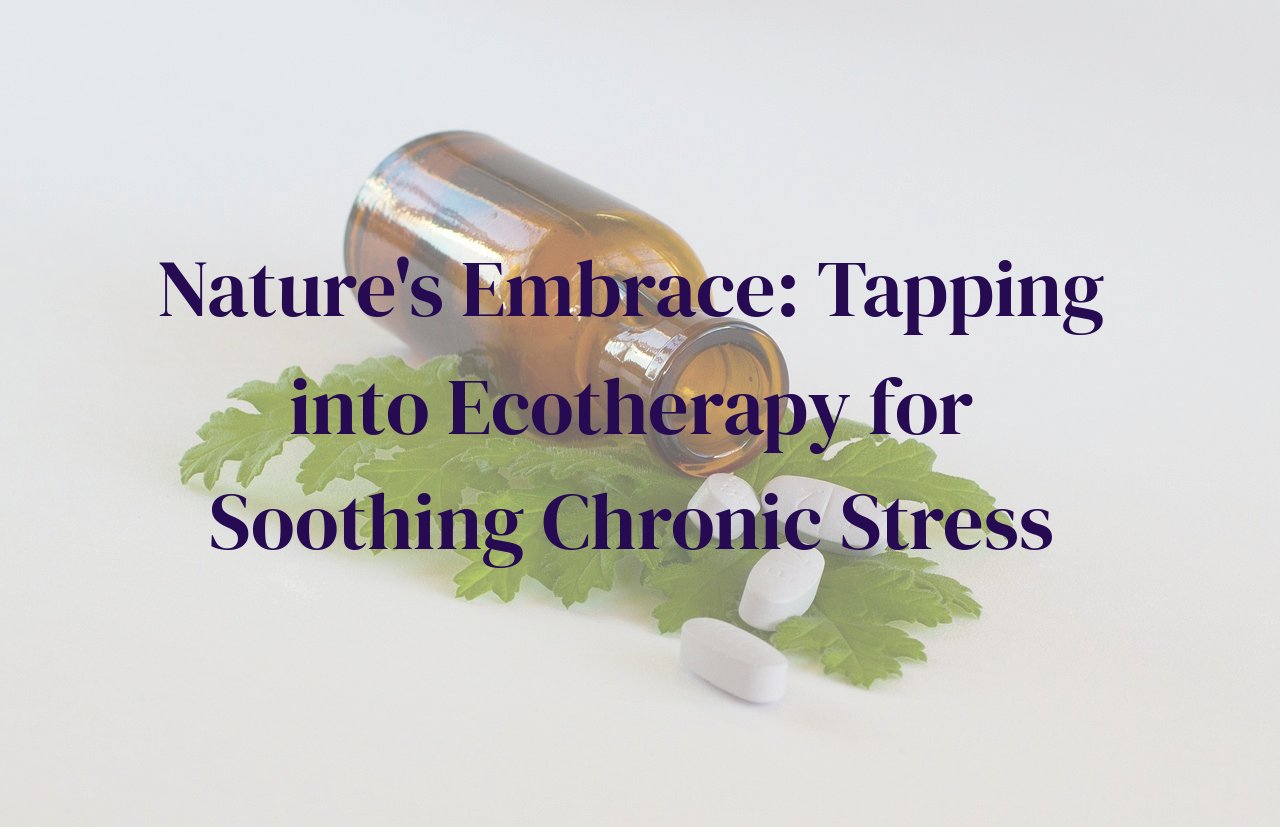
The clamor of daily life, with its unceasing demands and pervasive stressors, can take a toll on our mental and physical well-being. This post seeks to illuminate the calming realm of Ecotherapy—a therapeutic approach intertwining nature and mental health—and its efficacy in alleviating the burdens of chronic stress. As we delve into the heart of Ecotherapy, you will gain insights into how the natural environment can serve as a powerful ally in your quest for tranquility and resilience. Join us on a journey to discover the transformative impact of Ecotherapy on chronic stress and how it can foster a harmonious balance, transforming the struggle into serenity.
Table of Contents
Understanding Ecotherapy: Nature’s Prescription for Well-being
In the lush tapestry of therapeutic practices, ecotherapy emerges as a verdant strand, intertwining the human spirit with the serene pulse of the natural world. At its core, ecotherapy, or nature therapy, involves a series of engagements that guide individuals back to the embrace of nature’s healing powers. As we weave our way through the understanding of ecotherapy, imagine the dappled light of wisdom falling upon the paths of those yearning for tranquility.
Ecotherapy is grounded in the biophilia hypothesis, suggesting an innate human affinity towards nature, asserting that our evolutionary bond with the environment is an untapped elixir for well-being. This form of therapy doesn’t reside in a single technique but flourishes across a spectrum of activities. Picture the calmness that comes from a walk in an old-growth forest or the sense of completeness when your fingers dig into the warm earth of a garden; these are but two threads of ecotherapy’s rich fabric.
At the heart of ecotherapy is the belief that a disconnect from nature contributes to psychological and emotional stress, creating an environment within us as barren and disrupted as a landscape scarred by deforestation. Through ecotherapy, individuals are invited to rekindle their symbiotic relationship with the earth, often leading to transformative changes. Whether through horticultural therapy, which harnesses the nurturing process of plant-care, or wilderness therapy that immerses one in the challenges and beauty of untamed environments, ecotherapy plants the seeds of balance and growth.
The enchantment of ecotherapy lies not only in its variety but also in its accessibility. It beckons those confined by urban sprawl to find solace in the nearest park or community garden. It whispers to the overburdened soul to simply step outside and breathe in the symphony of a natural soundscape or to observe the delicate choreography of leaves dancing in the wind. Ecotherapy infuses life with the essence of nature, transforming everyday experiences into moments of deep connection and peace.
Thus, understanding ecotherapy is to recognize that even amidst a technological and fast-paced era, the most profound prescription for our well-being may just be the nurturing caress of the world outside our doors. It’s an invitation to disentangle from the web of chronic stress and bask in nature’s perennial wisdom. To engage in ecotherapy is to permit ourselves the joy of discovery, the pleasure of sensory immersion, and the profound tranquility that comes from being one with the earth. Indeed, perhaps the most restorative therapy begins with our feet planted firmly on the ground, beneath the canopy of the sky, within nature’s boundless embrace.
The Science Behind Ecotherapy: How Nature Heals
The enigmatic allure of nature has always been therapeutic, with its lush foliage, tranquil typography, and the symphony of life that resonates through every forest and meadow. In the core of ecotherapy, scientific studies corroborate the notion that engaging with nature can have profound effects on human stress levels. One compelling aspect is the concept of biophilia, suggesting an innate connection between humans and nature. When embraced, it fosters a sense of peace and well-being.
Research has highlighted various mechanisms by which nature exerts its healing properties. For instance, exposure to natural settings has been shown to lower cortisol levels, a hormone intricately linked with stress. Natural environments promote relaxation through sensory stimulation that is often absent in urban settings— the rustling leaves, the patterns of light and shadow, and the earthy scent of soil activate different senses and promote a meditative state.
Moreover, ecotherapy boosts concentration of mood-enhancing chemicals such as serotonin and dopamine. The mere act of walking through a green space can elevate endorphin levels and diminish brain activity associated with rumination, a common trait in chronic stress and depression. The fractal patterns in nature also have a unique calming effect on the brain, enabling individuals to recover from mental fatigue and cognitive overload. Findings from phytoncides, which are natural oils within plants, reveals how these substances reduce blood pressure and enhance immune system function, further contributing to stress alleviation.
Scientific inquiries have branched into studying the practice of ‘forest bathing’ or shinrin-yoku, where immersion in a forest setting can lead to measurable changes in physiology, reducing markers of stress and promoting an overall sense of vitality and rejuvenation. Interestingly, even viewing scenes of nature from a window can reduce stress and improve recovery rates in hospital patients, suggesting an implicit healing effect. The interaction with biodiverse environments also seems to influence the microbiome, which has emergent implications for mental health and stress resilience.
Essentially, ecotherapy encapsulates a multi-faceted therapeutic approach, rooted in the pure, empirical evidence of nature’s ability to restore and stabilize our mental states. By understanding and harnessing these natural interventions, we open the door to a more harmonious and less stressed existence. This intricate tapestry of scientific findings paints a clear portrait of the mutualistic relationship humans share with the environment and underscores the healing potential that nature graciously bestows.
Cultivating Stress Resilience: Practical Ecotherapy Techniques
In the realm of ecotherapy, various strategies stand as sentinels against the onslaught of chronic stress, each beckoning with a promise of peace and mental rejuvenation. One such strategy involves ‘Forest Bathing’, or Shinrin-yoku, a Japanese practice that invites individuals to fully immerse themselves in the forest atmosphere. The sensory journey of touching the rugged bark, inhaling the earthy scent of the undergrowth, and absorbing the verdant hues of the canopy has been shown to lower stress hormone levels, thereby fortifying one’s resistance to stress.
Another technique, referred to as ‘Horticultural Therapy’, allows participants to engage in gardening activities, cultivating not just plants but also a sense of achievement and connection. This hands-in-the-dirt approach can diminish feelings of anxiety and depression as one nurtures life from seed to blossom, fostering a nurturing relationship with living things which, in turn, nurtures the self.
Gentle ‘Nature Walks’ are yet another avenue to build resilience. Mere exposure to natural environments during regular walking expeditions has been associated with reduced activity in the prefrontal cortex, the brain region active during rumination – those repetitive, often negative thoughts that can fuel chronic stress.
Engagement with ‘Water-Based Activities’, such as sitting by a stream or paddling on a lake, can generate soothing effects. The sound of water has been linked to relaxation responses in the brain, a serene harmony that quiets the mind’s chatter and ushers in a state of calm.
Last but not least, the act of ‘Wildlife Observation’ connects us to the rhythmic patterns of natural life, offering an escape from the high-speed digital world that often contributes to our stress. Watching the unhurried pace of a butterfly or bird can instigate a profound shift towards a slower, more contemplative state of being where stress dissipates into the ether.
Branching Out: Incorporating Ecotherapy into Daily Life
In our modern world, rushing from task to task can sever the profound connection we share with nature. Yet, bringing the essence of ecotherapy into our everyday routines can be a surprisingly feasible endeavor. Rather than perceiving interaction with nature as a distant weekend affair, think of it as a tapestry of small, nourishing encounters woven throughout your life.
Start with Greening Your Commute. Turn part of your journey to work into a brief walk or bike ride through a park. The sights, sounds, and smells of nature can help clear your mind and reduce the cortisol levels associated with stress. If that’s not possible, consider at least parking further away from your destination to allow for a brief nature stroll.
Next, consider Al Fresco Dining. Take your lunch outdoors whenever you can. Whether it’s a picnic in the park or simply sitting under a tree, connecting with the environment while you eat can enhance digestion and lower stress.
Another technique is Plant Parenthood. Introduce houseplants into your living and working spaces. These green companions can purify the air and their presence has been shown to reduce stress levels. Even the act of nurturing a plant can be therapeutic.
Engage in Micro Nature Breaks. These are brief, intentional moments you take throughout your day to step outside, feel the sunlight on your skin, and breathe in fresh air. Even a few deep breaths while gazing at the sky can reset your stress levels.
Last but certainly not least, delve into the practice of Weekend Wilderness. Dedicate a part of your weekend to immerse yourself in nature. Be it a forest hike, a seaside stroll, or time in a local botanical garden, regularly scheduled nature time can serve as a deeper dive into the calming embrace of the Earth’s ecosystems.
By threading these ecotherapeutic practices into the fabric of everyday life, you offer yourself ongoing doses of nature’s serenity that cumulatively work to manage the storm of chronic stress. It’s about embracing every opportunity to invite nature’s touch into your daily rhythm and recognizing the cumulative wellbeing that arises from living life in harmony with the natural world.
The Root of Relief: Case Studies on Ecotherapy’s Success
The connection between nature and well-being stretches back through time, but only recently have we begun to understand the depth of its impact scientifically. In the realm of ecotherapy, real-world case studies shine a light on how this green prescription can reduce chronic stress. One poignant example emerged from a group study carried out in the dense woodlands of the Pacific Northwest. Participants who were suffering from high-stress levels engaged in guided forest walks and reported a remarkable decline in cortisol levels, a biological indicator of stress.
Across the ocean, in the UK, a project called ‘Green Gym’ has woven together the elements of nature and exercise, demonstrating substantial improvements in participants’ mood and self-esteem. Those engaging in conservation projects outdoors experienced not just physical health benefits but also a sense of accomplishment and community that fortified their mental health against everyday stressors.
Individuals battling profound stress disorders have also found solace in personal ecotherapy journeys. A diary of a war veteran with PTSD spoke volumes as it charted his pathway from reclusive anxiety to a place of calm, using daily garden work as his therapeutic ally. The hands-on interaction with soil and plants led him to a steadier mental state, showcasing the grounding power of tending to life’s natural cycles.
In bustling urban environments, where concrete often eclipses green space, the introduction of community gardens has been a beacon of stress relief as well. A study from a metropolitan area in Sweden illustrated how regular engagement with these green oases helped residents lower their stress levels and foster a spirit of kinship with both the earth and each other, bridging gaps in the social fabric.
Lastly, ecotherapy has not overlooked the youngest among us. Children with behavioral concerns have benefitted from structured nature-based interventions, such as in programs that incorporate therapeutic play in park settings. Observational research highlighted reductions in hyperactivity and improvements in attention spans, suggesting nature’s potential as a nurturing agent for the developing mind, amidst the chaos of modern life.
These snapshots of ecotherapy’s triumphs underscore the profound role nature can play in not just managing but actively transforming chronic stress into a state of regained balance and peace. The earth, it seems, provides an ancient antidote, eternally available for those who seek out its healing embrace.
Conclusion
Our exploration has led us through the restorative pathways of nature and its significant role in combatting chronic stress. The evidence and techniques presented are testament to the potent effects of Ecotherapy, offering a green beacon of hope for those yearning for relief from life’s relentless pressures. May the knowledge gained from this post inspire you to weave the natural world into your stress management tapestry, and may the whispering leaves and babbling brooks become trusted companions on your journey towards healing and inner peace.



